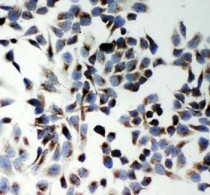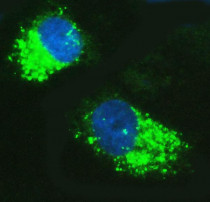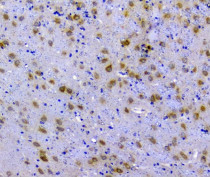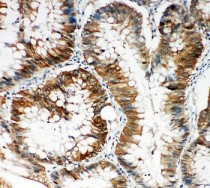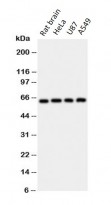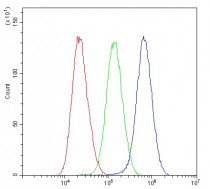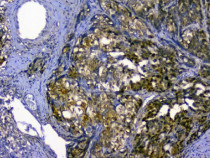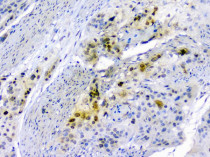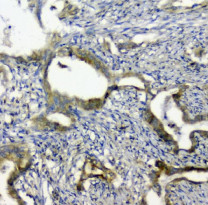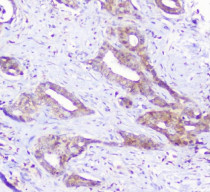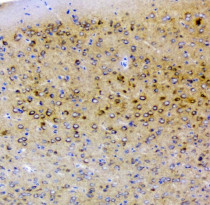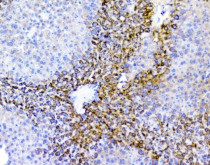ARG57285
anti-SQSTM1 / p62 antibody
anti-SQSTM1 / p62 antibody for Flow cytometry,ICC/IF,IHC-Formalin-fixed paraffin-embedded sections,Western blot and Human,Mouse,Rat
Cancer antibody; Cell Biology and Cellular Response antibody; Cell Death antibody; Gene Regulation antibody; Metabolism antibody; Signaling Transduction antibody; Autophagy Study antibody
Overview
| Product Description | Rabbit Polyclonal antibody recognizes SQSTM1 / p62 |
|---|---|
| Tested Reactivity | Hu, Ms, Rat |
| Tested Application | FACS, ICC/IF, IHC-P, WB |
| Host | Rabbit |
| Clonality | Polyclonal |
| Isotype | IgG |
| Target Name | SQSTM1 / p62 |
| Antigen Species | Human |
| Immunogen | Synthetic peptide around the N-terminus of Human SQSTM1 / p62. (KDDIFRIYIKEKKECRRDHR) |
| Conjugation | Un-conjugated |
| Alternate Names | FTDALS3; p60; p62; EBI3-associated protein of 60 kDa; p62B; Sequestosome-1; Ubiquitin-binding protein p62; PDB3; OSIL; Phosphotyrosine-independent ligand for the Lck SH2 domain of 62 kDa; EBIAP; A170; ZIP3 |
Application Instructions
| Application Suggestion |
|
||||||||||
|---|---|---|---|---|---|---|---|---|---|---|---|
| Application Note | IHC-P: Antigen Retrieval: Heat mediation was performed in EDTA buffer (pH 8.0). * The dilutions indicate recommended starting dilutions and the optimal dilutions or concentrations should be determined by the scientist. |
Properties
| Form | Liquid |
|---|---|
| Purification | Affinity purification with immunogen. |
| Buffer | PBS, 0.025% Sodium azide and 2.5% BSA. |
| Preservative | 0.025% Sodium azide |
| Stabilizer | 2.5% BSA |
| Concentration | 0.5 mg/ml |
| Storage Instruction | For continuous use, store undiluted antibody at 2-8°C for up to a week. For long-term storage, aliquot and store at -20°C or below. Storage in frost free freezers is not recommended. Avoid repeated freeze/thaw cycles. Suggest spin the vial prior to opening. The antibody solution should be gently mixed before use. |
| Note | For laboratory research only, not for drug, diagnostic or other use. |
Bioinformation
| Database Links | |
|---|---|
| Gene Symbol | SQSTM1 |
| Gene Full Name | sequestosome 1 |
| Background | SQSTM1 / p62 is a multifunctional protein that binds ubiquitin and regulates activation of the nuclear factor kappa-B (NF-kB) signaling pathway. The protein functions as a scaffolding/adaptor protein in concert with TNF receptor-associated factor 6 to mediate activation of NF-kB in response to upstream signals. Alternatively spliced transcript variants encoding either the same or different isoforms have been identified for this gene. Mutations in this gene result in sporadic and familial Paget disease of bone. [provided by RefSeq, Mar 2009] |
| Function | SQSTM1 / p62: Autophagy receptor required for selective macroautophagy (aggrephagy). Functions as a bridge between polyubiquitinated cargo and autophagosomes. Interacts directly with both the cargo to become degraded and an autophagy modifier of the MAP1 LC3 family (PubMed:16286508, PubMed:20168092, PubMed:24128730, PubMed:28404643, PubMed:22622177). Along with WDFY3, involved in the formation and autophagic degradation of cytoplasmic ubiquitin-containing inclusions (p62 bodies, ALIS/aggresome-like induced structures). Along with WDFY3, required to recruit ubiquitinated proteins to PML bodies in the nucleus (PubMed:24128730, PubMed:20168092). May regulate the activation of NFKB1 by TNF-alpha, nerve growth factor (NGF) and interleukin-1. May play a role in titin/TTN downstream signaling in muscle cells. May regulate signaling cascades through ubiquitination. Adapter that mediates the interaction between TRAF6 and CYLD. May be involved in cell differentiation, apoptosis, immune response and regulation of K(+) channels. Involved in endosome organization by retaining vesicles in the perinuclear cloud: following ubiquitination by RNF26, attracts specific vesicle-associated adapters, forming a molecular bridge that restrains cognate vesicles in the perinuclear region and organizes the endosomal pathway for efficient cargo transport (PubMed:27368102). Promotes relocalization of 'Lys-63'-linked ubiquitinated TMEM173/STING to autophagosomes (PubMed:29496741). Acts as an activator of the NFE2L2/NRF2 pathway via interaction with KEAP1: interaction inactivates the BCR(KEAP1) complex, promoting nuclear accumulation of NFE2L2/NRF2 and subsequent expression of cytoprotective genes (PubMed:20452972, PubMed:28380357). [UniProt] |
| Highlight | Related products: SQSTM1 antibodies; SQSTM1 Duos / Panels; Anti-Rabbit IgG secondary antibodies; Related news: Keap1-Nrf2-ARE antibody panel is launched Therapeutic strategies against PDAC |
| Research Area | Cancer antibody; Cell Biology and Cellular Response antibody; Cell Death antibody; Gene Regulation antibody; Metabolism antibody; Signaling Transduction antibody; Autophagy Study antibody |
| Calculated MW | 48 kDa |
| PTM | Phosphorylated. May be phosphorylated by PRKCZ (By similarity). Phosphorylated in vitro by TTN. Phosphorylation at Ser-403 by ULK1 is stimulated by SESN2 (PubMed:25040165). Ubiquitinated by RNF26: ubiquitinated SQSTM1 attracts specific vesicle-associated adapters, forming a molecular bridge that restrains cognate vesicles in the perinuclear region and organizes the endosomal pathway for efficient cargo transport (PubMed:27368102). Deubiquitination by USP15 releases target vesicles for fast transport into the cell periphery (PubMed:27368102). |
Images (15) Click the Picture to Zoom In
-
ARG57285 anti-SQSTM1 / p62 antibody ICC image
Immunocytochemistry: HeLa cells stained with ARG57285 anti-SQSTM1 / p62 antibody.
-
ARG57285 anti-SQSTM1 / p62 antibody ICC/IF image
Immunofluorescence: A549 cells were blocked with 10% goat serum and then stained with ARG57285 anti-SQSTM1 / p62 antibody (green) at 2 µg/ml dilution, overnight at 4°C. DAPI (blue) for nuclear staining.
-
ARG57285 anti-SQSTM1 / p62 antibody IHC-P image
Immunohistochemistry: Paraffin-embedded Rat brain tissue. Antigen Retrieval: Heat mediation was performed in EDTA buffer (pH 8.0). The tissue section was blocked with 10% goat serum. The tissue section was then stained with ARG57285 anti-SQSTM1 / p62 antibody at 1 µg/ml dilution, overnight at 4°C.
-
ARG57285 anti-SQSTM1 / p62 antibody IHC-P image
Immunohistochemistry: Parrafin-embedded Human intestinal cancer tissue stained with ARG57285 anti-SQSTM1 / p62 antibody.
-
ARG57285 anti-SQSTM1 / p62 antibody WB image
Western blot: Rat brain, HeLa, U87, and A549 cell lysates stained with ARG57285 anti-SQSTM1 / p62 antibody.
-
ARG57285 anti-SQSTM1 / p62 antibody FACS image
Flow Cytometry: A549 cells were blocked with 10% normal goat serum and then stained with ARG57285 anti-SQSTM1 / p62 antibody (blue) at 1 µg/10^6 cells for 30 min at 20°C, followed by incubation with DyLight®488 labelled secondary antibody. Isotype control antibody (green) was rabbit IgG (1 µg/10^6 cells) used under the same conditions. Unlabelled sample (red) was also used as a control.
-
ARG57285 anti-SQSTM1 / p62 antibody IHC-P image
Immunohistochemistry: Paraffin-embedded Human gastric cancer tissue. Antigen Retrieval: Heat mediation was performed in EDTA buffer (pH 8.0). The tissue section was blocked with 10% goat serum. The tissue section was then stained with ARG57285 anti-SQSTM1 / p62 antibody at 1 µg/ml dilution, overnight at 4°C.
-
ARG57285 anti-SQSTM1 / p62 antibody IHC-P image
Immunohistochemistry: Paraffin-embedded Human lung cancer tissue. Antigen Retrieval: Heat mediation was performed in EDTA buffer (pH 8.0). The tissue section was blocked with 10% goat serum. The tissue section was then stained with ARG57285 anti-SQSTM1 / p62 antibody at 1 µg/ml dilution, overnight at 4°C.
-
ARG57285 anti-SQSTM1 / p62 antibody IHC-P image
Immunohistochemistry: Paraffin-embedded Human oesophagus squama cancer tissue. Antigen Retrieval: Heat mediation was performed in EDTA buffer (pH 8.0). The tissue section was blocked with 10% goat serum. The tissue section was then stained with ARG57285 anti-SQSTM1 / p62 antibody at 1 µg/ml dilution, overnight at 4°C.
-
ARG57285 anti-SQSTM1 / p62 antibody IHC-P image
Immunohistochemistry: Paraffin-embedded Human rectal cancer tissue. Antigen Retrieval: Heat mediation was performed in EDTA buffer (pH 8.0). The tissue section was blocked with 10% goat serum. The tissue section was then stained with ARG57285 anti-SQSTM1 / p62 antibody at 1 µg/ml dilution, overnight at 4°C.
-
ARG57285 anti-SQSTM1 / p62 antibody IHC-P image
Immunohistochemistry: Paraffin-embedded Human sarcoma tissue. Antigen Retrieval: Heat mediation was performed in EDTA buffer (pH 8.0). The tissue section was blocked with 10% goat serum. The tissue section was then stained with ARG57285 anti-SQSTM1 / p62 antibody at 1 µg/ml dilution, overnight at 4°C.
-
ARG57285 anti-SQSTM1 / p62 antibody IHC-P image
Immunohistochemistry: Paraffin-embedded Human cholangiocarcinoma tissue. Antigen Retrieval: Heat mediation was performed in EDTA buffer (pH 8.0). The tissue section was blocked with 10% goat serum. The tissue section was then stained with ARG57285 anti-SQSTM1 / p62 antibody at 1 µg/ml dilution, overnight at 4°C.
-
ARG57285 anti-SQSTM1 / p62 antibody IHC-P image
Immunohistochemistry: Paraffin-embedded Human liver cancer tissue. Antigen Retrieval: Heat mediation was performed in EDTA buffer (pH 8.0). The tissue section was blocked with 10% goat serum. The tissue section was then stained with ARG57285 anti-SQSTM1 / p62 antibody at 1 µg/ml dilution, overnight at 4°C.
-
ARG57285 anti-SQSTM1 / p62 antibody IHC-P image
Immunohistochemistry: Paraffin-embedded Mouse brain tissue. Antigen Retrieval: Heat mediation was performed in EDTA buffer (pH 8.0). The tissue section was blocked with 10% goat serum. The tissue section was then stained with ARG57285 anti-SQSTM1 / p62 antibody at 1 µg/ml dilution, overnight at 4°C.
-
ARG57285 anti-SQSTM1 / p62 antibody IHC-P image
Immunohistochemistry: Paraffin-embedded Rat liver tissue. Antigen Retrieval: Heat mediation was performed in EDTA buffer (pH 8.0). The tissue section was blocked with 10% goat serum. The tissue section was then stained with ARG57285 anti-SQSTM1 / p62 antibody at 1 µg/ml dilution, overnight at 4°C.
